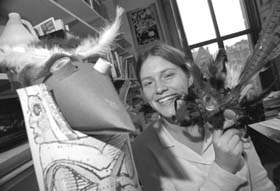
Claire Heenan: Outing the Redpath
Claire Heenan still can't quite believe her good luck: fresh out of university, she is working in a job that uses all her skills and allows her to develop the ideas and practices she began in her geography studies at McGill. What's more, unlike her three older siblings and many of her friends, she's got work in Montreal.
"It feels funny to have made this switch so rapidly from being a student to being a staff member," says the 24-year-old, comfortably seated at her well-worn desk. As she chats, she is surrounded by crafts materials, posters of whales and other exotica of natural history, the substance of the Redpath Museum where she began in September as the institution's first ever science educator.
While some readers will already know Heenan as the woman in costume teaching their children the benevolence of bats or the antics of ants -- and getting them to make highly original handicrafts on the week's theme, to boot -- few realize that the Sunday afternoon Discovery Workshops are but a third of her work.
Heenan is also responsible for handling visits from schools, training docents (volunteer tour guides), meeting with the 140-strong Friends of the Redpath volunteers and donors, coordinating some of the 20 student volunteers and raising funds to increase the programming and accessibility of the museum.
The Redpath has had part-time animators for its Discovery Workshops for a few years now, but Heenan's position, with its other responsibilities, is brand new. The science educator position, a yearly contract, was made possible thanks to an anonymous donor.
Heenan has been thinking up schemes for making the Redpath better known and used. One goal is to prepare specialized educational materials -- an activity package for schoolchildren that would lead them on a treasure hunt to find such Redpath holdings as the Albertasaurus, the mummy and the ostrich egg, for instance. Another involves developing a floor plan of the 116-year-old museum for visitors. Ideas, of course, cost money to implement.
In that vein, Heenan, who got her fundraising experience while working for NDP candidate Tooker Gomberg in the last federal election, is trying to heighten the museum's profile so that it will take its place alongside Montreal's other museums, not only as an enjoyable and educational place to visit, but also as a place in which to hold receptions and parties.
"We have to put it on the map, get society people in, those with connections," says Heenan, the daughter, in fact, of one society person, lawyer Roy Heenan of the well-known law firm which carries his name.
What excites Heenan most about her mandate to popularize the Redpath is her belief in the museum as a vehicle for attuning people to the natural world, its strength and fragility and our relationship to it. "I had a humanities student in here, for instance, who didn't know that the Earth was made of molten rock. This place is a great introduction to the sciences relating to life," recounts Heenan, adding that she draws inspiration from "hanging out and chatting with people who have been coming here for 50 years, who have their favourite rock."
While Heenan "always had a craft drawer," having to prepare the 11 workshops offered this fall means considerable research, not only on the subject, but also on the handicraft. "I've had to learn tons," says Heenan, who is "just learning about the world of hot glue guns, plaster of Paris" and is grateful for the tips from the Redpath's paleontology curator, Ingrid Birker, and geology curator, Joan Kaylor.
She's also grateful for the diversity of tasks involved in her job: "I don't get stuck in a rut," says Heenan, who has just been working on creating databases on the number and variety of Redpath visitors. "I have all this organizational stuff to do, then I switch to the right side of the brain to figure out a craft to make."
Bronwyn Chester
|



